This past week, winter entered the Central Texas picture with temperatures dipping to the mid 20s F/below 0 C, for several nights and mornings. I realize that’s nothing to what the mid-west and elsewhere regularly endures, but it is a definitive so long to the blooming southwest garden! and hello! to wilted and freeze-crisped plants. I miss flowers in winter, but I welcome the cold(er) season exit of herbaceous perennials. I like the bare-bones of a garden revealed, to better assess needed garden changes.
Fun to see after a hard freeze are the ice sculptured stems of Frostweed, Verbesina virginica.
Elegant ice ribbons form when water in the stems expands rapidly during the first hard freeze of the season, exuding sap which freezes quickly and into delicate, fantastical shapes along the length of the stems.
Wavy and curvy, the ice sheets are delicate and fragile.
This one rocks a fungal look reminiscent of an earlier, warmer time.
The ice ribbons usually appear near the base of the plant, but can develop along any stem–the key is plenty of sap within those epidural walls. My Frostweeds weren’t yet dormant, allowing for plenty of moisture to freeze.
I’d trimmed this Frostweed ahead of a soon-to-begin fence project.
…and ice ribbons hug the 5 or 6 inches of remaining stems, looking like a scroll which needs unrolling.
Frostweed isn’t the only plant which produces these types of frozen sculptures, but it is a reliable ice artist in my garden.
The ice is fragile, the sculpture ephemeral. Once the temperature rises above freezing, the natural sculpture is finished for another year.
Frostweed is an excellent plant for pollinators and birds, which is the primary reason I grow it,
…but the ice sculptures are well-worth the winter show for the gardener.
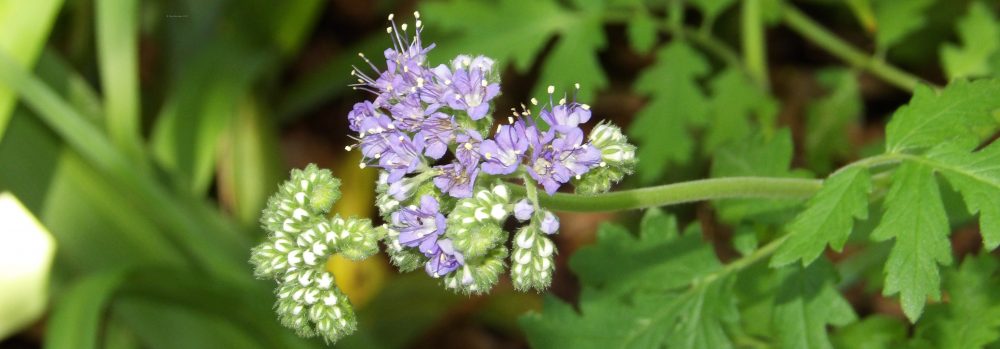
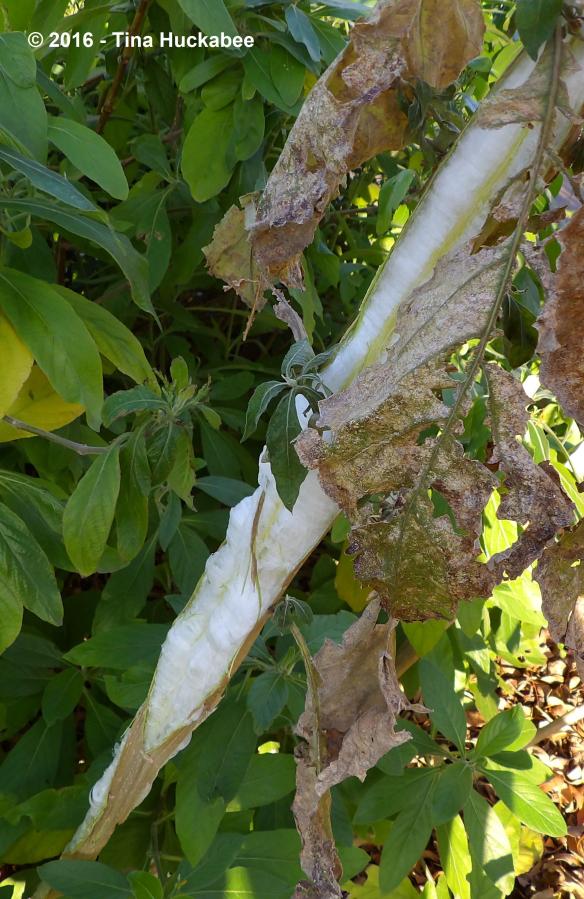

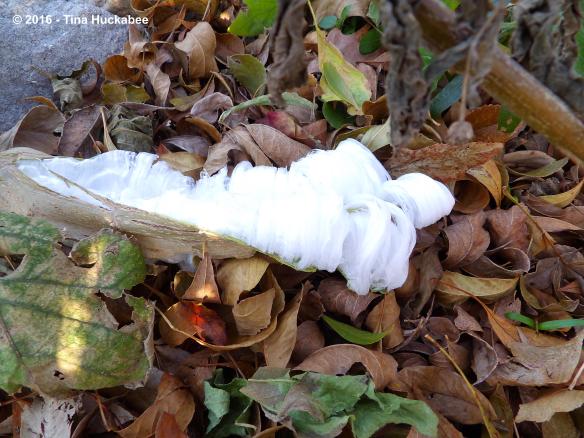
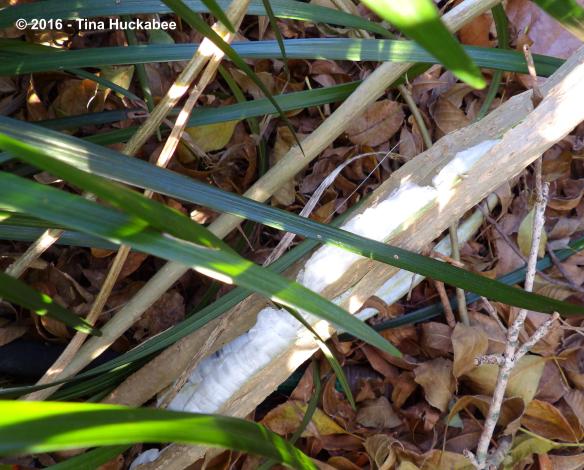
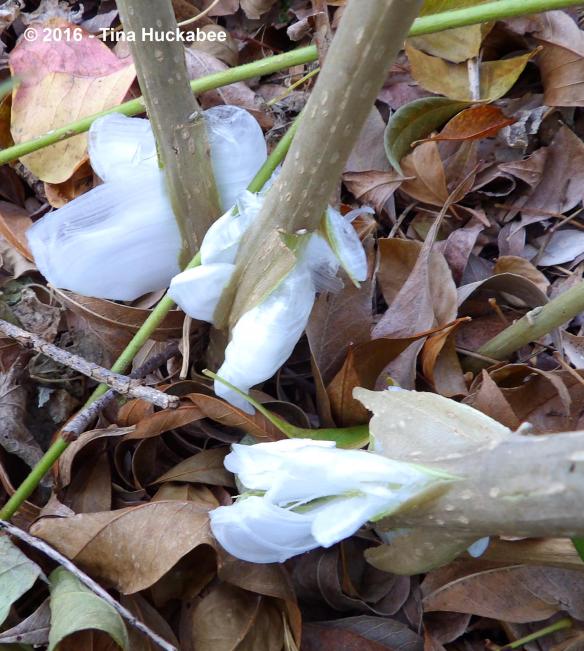
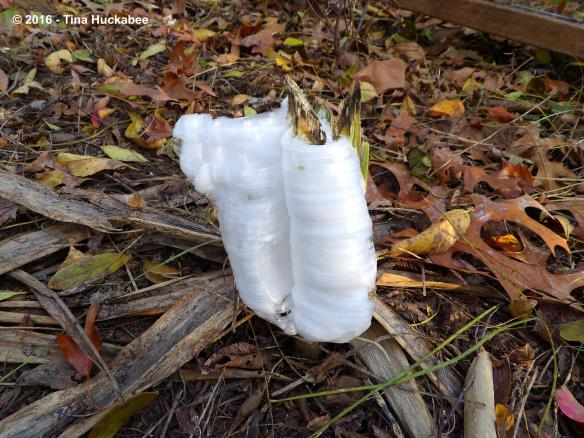



Wonderful photos! Am I jealous? Yes, I am. I had my fingers crossed, and we made it down to 31F at 5 a.m., but by the time I got out, about 6:30, it was already at 33 and we soon were at 34. That’s what happens when you live surrounded by water. The frostweed was abundant, but it just was sitting there, with not a bit of ice to be seen.
There’s still hope, perhaps, if we get a real freeze in January. The stems were nice and firm, and not any more raggedy than you’d expect at this time of year. We’ll see. If I miss it again this year, I’m going to find some patches north and west, maybe out at the wildlife refuge where it won’t be mowed, and resign myself to driving. The nature centers here that have the most don’t open until 9 a.m. — not good for frostweed lovers.
LikeLike
Thanks! It’s been a couple of years since just the right conditions (uh, winter) were in play–a rapid temperature drop (from 78F on Saturday to 28F Sunday morning–let’s hear it for nutty Texas weather!), so that the stems would split with drama. Our winters are just more mild and that hard freeze isn’t happening with the regularity that it once did. You’re right that being near water is going to warm you up a bit. You need to plan a trip to north Texas or Arkansas and time it with that first frost. Just keep the rain and ice out of the picture–we don’t know how to drive in that!
LikeLiked by 1 person
These are gorgeous. Never seen anything like it before. What a marvellous effect. Great photos Tina!
LikeLike
Thanks!! I was happy to see the ice sculptures this year, as we had no freezes last. If you click on the highlighted “Frostweed” link, you can see some even more remarkable sculptures on the Wildflower Center’s website. My sculptures were pretty tame in comparison.
LikeLiked by 1 person
Beautiful sculptures! Does the plant come back from the root?
LikeLike
Thank you! Yes, Frostweed is very tough and will come back with no problems. I just moved a couple of mature ones a few weeks back and I have no doubt that they’ll be up and running in spring.
LikeLiked by 2 people
The story behind the name “frost”weed is so interesting, and such neat ice sculptures! We have a wild one, Verbesina encelioides, mainly on open sites or disturbed areas. I don’t think gardeners would use it, kinda rangy. I wonder if it has the same frost action? The “official” common name is golden crownbeard.
LikeLike
It’s a great plant in all of its stages. Actually, our frostweed is rangy too–those who demand the tidy, neat garden would probably be unhappy with it!
LikeLike
Thanks for this post, Tina. I hadn’t known about Frostweed and though we don’t get it here (that I know of) it’s nice to be able to get a view of this winter-world from another’s perspective. It’s a fascinating plant in its many frozen states. Here, I tend just to curl up in front of a heater and try to avoid looking outdoors!
LikeLike
Glad you enjoyed it, Val. Our winters are mild, though we do have days that all one wants to do is the ‘curl up’ and be warm!
LikeLiked by 1 person
What an interesting phenomenon – I learned something new! Great captures, too. 🙂
LikeLike
Thanks, Anna! I love to read about plants that grow in other places, other gardens, too.
LikeLike
What an interesting plant. Enjoy the season.
LikeLike
Thank you–and you enjoy as well!!
LikeLike
I enjoy seeing these Frostweed photos! What a wonderful show nature gives us in all seasons. I’m a little too far north for it, but it’s fun to see this plant highlighted on gardening blogs.
LikeLike
Glad you enjoyed, Beth. Frostweed is a fun plant in the garden, but its range doesn’t extend to your neck- of- the- woods, I’m sorry to say.
LikeLike
How beautiful, I have never heard of frost weed, what an amazing plant. Lovely photos.
LikeLike
Thanks, Chloris. Frostweed is native from Pennsylvania to Texas and Florida.
LikeLike
I am sorry you got frosted Tina 🙂 but happy that I found out about the frostweed plant. Never seen something like it – and it makes for very interesting pictures!
LikeLike
Ha ha, I’m embarrassed to even consider complaining when I see snow drifts from other places. It was fun to see the sculptures on the frostweed this year.
LikeLiked by 1 person
That’s fascinating – I had never heard of this. Thanks for this post!
LikeLike
You’re most welcome!!
LikeLiked by 1 person
I’ve never seen anything like this. What fun!
LikeLike
It is a fun plant in the garden!
LikeLiked by 2 people
Tina que fotos más increíbles del Frostweed. Algunas parecen hechas para ser fotografiadas: una planta muy fuerte que renace de sus raíces y muy bonita. Feliz Navidad y Feliz Año Nuevo. Saludos de Margarita.
LikeLike
Thank you, Margarita–I hope your 2017 is wonderful!
LikeLike
Very cool!! 🙂
LikeLike
Cold and frozen, actually. 🙂 But thanks!
LikeLike
Pingback: Frost Again | My Gardener Says…